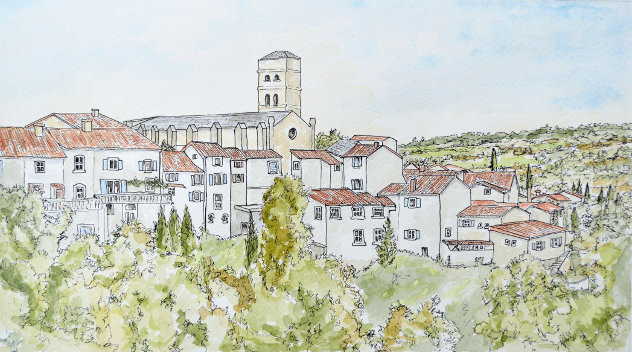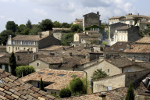Glossary French Residential Buildings
James Latter, Saturday, 25 March 2017

Appartement - Collection of reception rooms and habitable space and service rooms forming a ‘logement’.
Batisse - A solid structure (to denote impregnability) built of stone, sometimes the remnant of an ancient building (e.g. abbey) or wall modified or used as part of a new building.
Cabane (en ) - Rural, rudimentary construction forming a shelter built of dry stone.
Chalet - Alpine dwelling, frquently of timber construction on stone base.
Chartreuse - Architecture/style Louis XVI – smallish château, typically found in the Guyenne and Bordelais wine region – built in the 8th and 19th centuries. Served as country houses for local aristocracy. Mainly low buildings without upper floors and opening onto terraces and gardens,(Aquitaine). e.g. Beycherelle and Loudenne
Château - (of post Renaissance to revolution style) - belonging to principal noble of the area - 600m2+. Architecturally elegant with sumptuous interior.
Château-fort - Medieval chateau with defences.
Chaumière - A thatched cottage.
Demeure - Habitation formed by a Logis and its dépendances (palais, hôtel, château, manoir etc.)
Dépendance - Part of a ‘demeure’ destined for garden, farming, artisanal, industrial use e.g. Serre, orangerie,colombier d'un chateau etc.
Dimière - (11th-18th Century) Ancient tithe barn ‘grange dimière’, rectangular and solid with high roof, used for collecting and storing the tithes or ‘dimes’. Frequently stone built and with ecclesiastical architecture/associations.
Domaine - An estate, comprising a Chateau or chartreuse etc. and depending on size, might include manoir and other dwellings. Sometimes describes wine-producing estate (often smaller)
Ferme - Farm – comprising a ‘logis’ and some dépendances for agricultural exploitation.
Corps de Ferme - The central farm courtyard, i.e house and close outbuildings (grange) and a plot of land no longer commercially viable for farming.
Gentilhommière - Gentleman's /aristocrat's residence, a larger and more elegant equivalent of a manoir. (Sometimes described as a 'logis seigneuriale'.)
Grange - Building for storage of harvest/grain or straw etc.
Hangar - Shelter - open with roof only to house agricultural machinery.
Hôtel Particulier - A town mansion of substance, frequently with a habitable surface area of around 600 to 800 m², once with courtyard and stabling. E.g. Hôtel Garnier, Paris, Hôtel Fenwick, Bordeaux. Typically merchant’s residence, late 1800’s.
Immeuble - Town apartment block divided in its construction to provide apartments for several private owners/tenants. Sometimes with commercial use at street level.
Loft - A converted attic often in an 'immeuble'.
Logis - Part of a ‘demeure’ containing one or more apartments. eg. Logis de l’abbé, Logis du gouverneur.
Longère - Country long-house, originally with living accommodation one end and barn/stable or ‘mangeoire’ the other end. Now renovated in many cases with first floor bedrooms in roof space ‘en –enfilade’ (contiguous).
Maison de Campagne - Country house with two storeys and attic with small outbuilding
Maison de Maître - Sizeable detached town house of ‘importance’ – 300/400 m² found frequently on the fringe of a small town. Often used to house the large extended family of a merchant or lawyer, doctor etc.
Maison de Ville - Standard town house, frequently 'mitoyenne' (semi-detached or terraced).
Manoir - Principally rural with feudal connections, occupied by a family of minor noble birth (local decision makers) and surrounded by agricultural land – deemed to be self-sufficient. Unpretentious in style. Generally with a habitable surface of 250 – 600m², sometimes with tower and notional fortifications.
Mas - Provencal farm or country house, frequently associated with a vineyard or olive plantation.
Pavillon - The French equivalent of a ‘chalet-bungalow’ of modern build, frequently on a lotissement (housing estate). Typically around 100/140m² habitable surface. Often disproportionately large roof not always housing bedrooms. Small plot of 400/600 m2.
Terrain - The surface area of land (the plot) occupied by the building and including the building's footprint surface area.
Villa - Detached seaside dwelling sometimes secondary residence, denoting holiday/leisure use. Inland, a more luxurious ‘pavillon’. E.g. Le Touquet'
This article was originally published on www.surveyor-expert.com. However, this website is no longer active.

Appartement - Collection of reception rooms and habitable space and service rooms forming a ‘logement’.
Batisse - A solid structure (to denote impregnability) built of stone, sometimes the remnant of an ancient building (e.g. abbey) or wall modified or used as part of a new building.
Cabane (en ) - Rural, rudimentary construction forming a shelter built of dry stone.
Chalet - Alpine dwelling, frquently of timber construction on stone base.
Chartreuse - Architecture/style Louis XVI – smallish château, typically found in the Guyenne and Bordelais wine region – built in the 8th and 19th centuries. Served as country houses for local aristocracy. Mainly low buildings without upper floors and opening onto terraces and gardens,(Aquitaine). e.g. Beycherelle and Loudenne
Château - (of post Renaissance to revolution style) - belonging to principal noble of the area - 600m2+. Architecturally elegant with sumptuous interior.
Château-fort - Medieval chateau with defences.
Chaumière - A thatched cottage.
Demeure - Habitation formed by a Logis and its dépendances (palais, hôtel, château, manoir etc.)
Dépendance - Part of a ‘demeure’ destined for garden, farming, artisanal, industrial use e.g. Serre, orangerie,colombier d'un chateau etc.
Dimière - (11th-18th Century) Ancient tithe barn ‘grange dimière’, rectangular and solid with high roof, used for collecting and storing the tithes or ‘dimes’. Frequently stone built and with ecclesiastical architecture/associations.
Domaine - An estate, comprising a Chateau or chartreuse etc. and depending on size, might include manoir and other dwellings. Sometimes describes wine-producing estate (often smaller)
Ferme - Farm – comprising a ‘logis’ and some dépendances for agricultural exploitation.
Corps de Ferme - The central farm courtyard, i.e house and close outbuildings (grange) and a plot of land no longer commercially viable for farming.
Gentilhommière - Gentleman's /aristocrat's residence, a larger and more elegant equivalent of a manoir. (Sometimes described as a 'logis seigneuriale'.)
Grange - Building for storage of harvest/grain or straw etc.
Hangar - Shelter - open with roof only to house agricultural machinery.
Hôtel Particulier - A town mansion of substance, frequently with a habitable surface area of around 600 to 800 m², once with courtyard and stabling. E.g. Hôtel Garnier, Paris, Hôtel Fenwick, Bordeaux. Typically merchant’s residence, late 1800’s.
Immeuble - Town apartment block divided in its construction to provide apartments for several private owners/tenants. Sometimes with commercial use at street level.
Loft - A converted attic often in an 'immeuble'.
Logis - Part of a ‘demeure’ containing one or more apartments. eg. Logis de l’abbé, Logis du gouverneur.
Longère - Country long-house, originally with living accommodation one end and barn/stable or ‘mangeoire’ the other end. Now renovated in many cases with first floor bedrooms in roof space ‘en –enfilade’ (contiguous).
Maison de Campagne - Country house with two storeys and attic with small outbuilding
Maison de Maître - Sizeable detached town house of ‘importance’ – 300/400 m² found frequently on the fringe of a small town. Often used to house the large extended family of a merchant or lawyer, doctor etc.
Maison de Ville - Standard town house, frequently 'mitoyenne' (semi-detached or terraced).
Manoir - Principally rural with feudal connections, occupied by a family of minor noble birth (local decision makers) and surrounded by agricultural land – deemed to be self-sufficient. Unpretentious in style. Generally with a habitable surface of 250 – 600m², sometimes with tower and notional fortifications.
Mas - Provencal farm or country house, frequently associated with a vineyard or olive plantation.
Pavillon - The French equivalent of a ‘chalet-bungalow’ of modern build, frequently on a lotissement (housing estate). Typically around 100/140m² habitable surface. Often disproportionately large roof not always housing bedrooms. Small plot of 400/600 m2.
Terrain - The surface area of land (the plot) occupied by the building and including the building's footprint surface area.
Villa - Detached seaside dwelling sometimes secondary residence, denoting holiday/leisure use. Inland, a more luxurious ‘pavillon’. E.g. Le Touquet'
This article was originally published on www.surveyor-expert.com. However, this website is no longer active.

Search for French property and real estate for sale in all regions of France. Fermettes, gites, houses, B&B’s for sale by owner. Houses for sale in Gironde, Dordogne, Landes, Calvados, Manche and Orne
 France enacts a groundbreaking law to protect the sounds and smells of rural life from complaints by newcomers, or "néoruraux." This move aims to
preserve French countryside culture, ensuring harmony between long-standing residents and those attracted to rural charms. The legislation marks a
significant step in valuing and safeguarding France's rural heritage.
France enacts a groundbreaking law to protect the sounds and smells of rural life from complaints by newcomers, or "néoruraux." This move aims to
preserve French countryside culture, ensuring harmony between long-standing residents and those attracted to rural charms. The legislation marks a
significant step in valuing and safeguarding France's rural heritage.